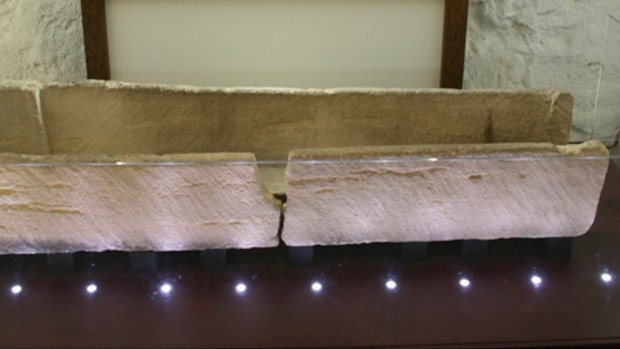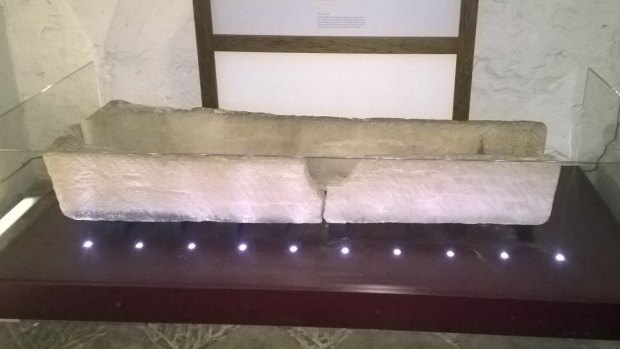This was published 7 years ago
Child breaks 800-year-old coffin after family photograph goes wrong
By Christopher Mele
New York: The grounds of Prittlewell Priory, a museum and park in Southend-on-Sea in Britain, about 65 kilometres east of London, feature gardens, buildings and exhibits depicting what life was like there centuries ago.
In online reviews, visitors praise the site for being attractive and inviting.

An 800-year-old sandstone coffin at Prittlewell Priory before it was damaged.Credit: Southend-on-Sea Borough Council
For one family, though, it might have been a bit too inviting.
An 800-year-old sandstone coffin was damaged on Sunday after the family put a child into it for a photo. The fragile sarcophagus fell, with a small piece breaking off altogether, museum officials said.

The coffin after it was damaged.Credit: Southend-on-Sea Borough Council
Closed circuit television cameras were recording in the museum and captured the family, but the pictures do not show the incident clearly. The family left without reporting the damage.
The episode is the latest example of museum visitors damaging artefacts or artworks by taking photos, touching exhibits or letting their children get too close to them. Curators are increasingly being forced to consider worst-case scenarios while trying to strike a balance between protecting exhibits and making them accessible, experts said.
The Southend-on-Sea Borough Council, which owns and operates Prittlewell Priory, has the broken shard from the coffin, and its conservator will use special adhesives to repair it. Officials estimated repairs would cost about £100, or about $162.
Conservator Claire Reed told the BBC staff were "shocked and upset" after discovering the damage.
"Staff heard a thump and that was the first indication something had happened," she said.
"It was one of those isolated, terrible incidents. You can put all the risk assessments in place but you really don't expect people to try to get into the artefacts.
"It's a very important artefact and historically unique to us as we don't have much archaeology from the priory."
The coffin was found on the site in 1921, complete with a skeleton that could have been a senior monk who lived at the priory, which was founded in the 12th century.
Ann Holland, executive councillor for culture, tourism and the economy for the borough council, said in the statement that officials believed the coffin would need to be completely enclosed to prevent further damage. Photos show it was previously surrounded by only a low, clear barrier.
"The area will reopen as soon possible," she said. "In the meantime, we would like to remind all visitors that they should observe and respect any barriers and signs in place that are there to protect our important heritage and history."
Clearly others need reminding too.
In February, at the exhibition Infinity Mirrors at the Hirshhorn Museum and Sculpture Garden in Washington, a visitor trying to take a selfie fell into a patch of glass pumpkin sculptures and broke one of them.
Two children at the Shanghai Museum of Glass were caught on camera last year touching Angel Is Waiting, a sculpture by Shelly Xue, as their parents recorded them. When one child pulled the sculpture away from the wall, it fell and broke.
And a 90-year-old woman visiting the Neues Museum in Nuremberg, Germany, last year used a pen to fill in the spaces in an artwork, Reading-work-piece, by avant-garde artist Arthur Koepcke, which depicted part of a crossword puzzle.
The risky behaviour extends to wildlife at national parks. Visitors have started taking selfies dangerously close to bison at Yellowstone National Park, prompting #bisonselfie to become a popular topic on Twitter and Instagram.
So much of our modern mindset is to document ourselves while immersed in experiences, Wayne J. LaBar, president of the board of the National Association for Museum Exhibition, a professional network of the American Alliance of Museums, said on Thursday.
"Nowadays, everything is a photo opportunity. Things are designed for me to be a participant and not just an observer," he said.
In the case of the damaged coffin, one online reviewer put the responsibility on the adults.
"It's a very good place to take your unruly spoilt kids if they are in the mood to damage 800-year-old coffins," a reviewer on TripAdvisor wrote about the priory under the title "Loads of things to break" on Wednesday. "Remember to leave quickly before anyone discovers the damage. Shame on you!"
New York Times